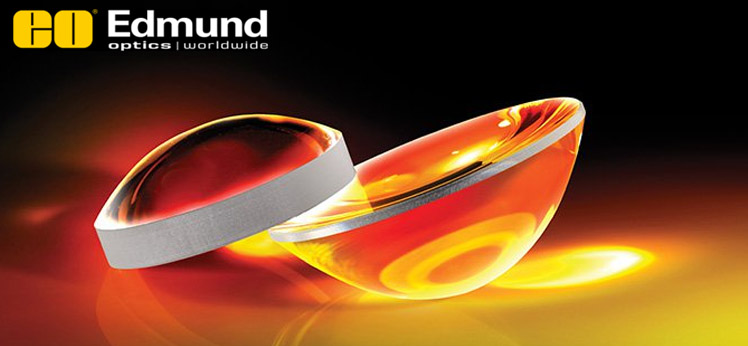The future depends on monitoring and regulating air pollution, which is an essential step towards creating a cleaner environment.
MONITORING MARITIME POLLUTION WITH OPTICS
Monitoring and regulating air pollution is an essential step towards creating a cleaner environment. Danfoss IXA, a high-tech company based in Denmark, is developing a device called MES 1001, a marine emission sensor based on ultraviolet absorption spectroscopy which monitors the NO, NO2, SO2 and NH3 emissions produced by cargo ships to ensure that they are complying with all environmental regulations. The optical sensor is placed inside the exhaust system of ships, so the involved optics will be exposed to extreme conditions and must be able to withstand temperatures up to 500°C and very high pressures simultaneously.
Danfoss IXA was looking for a partner to develop optics fulfilling their demanding requirements, and in EDMUND OPTICS (EO) they found a partner who was prepared to take on this challenge which went beyond their normal capabilities. EO created custom test beds for verifying the unique requirements of the sensor, which enabled EO to develop a robust system to meet Danfoss IXA’s specifications.
Danfoss IXA develops sensors and systems for the maritime industry, focusing on energy optimization and the measurement of emission gases. They are a part of the Danfoss Group, a global enterprise which produces a wide range of technologies that address a variety of markets including food supply, energy efficiency, and climate-friendly solutions.
Smokestack emissions from international shipping are a severe problem for human health, contributing to the premature mortality of people all across the world from lung damage and cardio vascular diseases.
CREATING A CLEANER ENVIRONMENT STARTS AT SEA
The International Maritime Organization (IMO) has recently decided that commercial ships must comply with low sulfur fuel requirements globally by 2020. In addition, the current Nitrogen Oxide emission control area along the North American coastline will be expanded to cover the Baltic and North Seas in 2021. There currently aren’t convenient and reliable ways for the IMO to monitor ships’ emissions and enforce these regulations. A multitude of local and regional initiatives seeking to limit the air emission from ships further underline the fact that the industry needs to adapt to a world where strict emission requirements are part of the game. Danfoss IXA is developing the MES1001, which is a comprehensive marine emissions sensor suitable for accurately measuring a ship’s air emissions in real time.
THE CHALLENGE
Danfoss IXA approached several providers of optical components to jointly design the optical system for the new MES 1001 device. This project turned out to be very challenging due to the extreme high temperature and pressure requirements. High temperatures can cause optics to fail due to melting and thermal stresses, which severely limits the types of optical materials that can be used. High temperatures can also cause adhesives used in the optical assembly to outgas, contaminating the system. The high pressure requirements made the sealing of the optical system critically important. Most of the optics partners faced their limits in terms of design, metrology for these harsh conditions, or working across different continents and time zones.
THE SOLUTION
EDMUND OPTICS (EO), with its global presence and large staff of optical engineers and designers, is always keen to face new challenges. One of the reasons that Danfoss IXA selected EO as a partner is their ability to ramp-up products from prototype to volume production. When approached by Danfoss, EO dedicated R&D and project management resources to developing an optical assembly for the MES 1001, even though EO had never designed systems to work at temperatures as high as 500°C before. EO investigated many different materials and mounting options, recognizing this project as a learning experience and opportunity to expand their capabilities. Custom testbeds for verifying the optical system’s unique requirements were created and proper sealants and optomechanics were identified to allow the assembly to survive these high pressures. The start of that development process was faced with many issues including cracking optics and outgassing adhesives, but by iterating the design process multiple times and researching in different materials these issues were solved and Edmund Optics eventually delivered an optical assembly that could survive the harsh environment inside a ship’s exhaust system. Edmund Optics is proud to be a part of this product which will positively impact the environment and support a global effort to reduce harmful emissions.
Danfoss IXA “greatly appreciated EO’s professional way of involving [them] along the development process as well as their ability to adapt to changing requirements as [Danfoss IXA] learned more about the exact conditions in which the sensor would be used.” During that time Danfoss IXA “found the support from EO’s project managers extremely fruitful and very efficient in bringing the development process to success.”
The robust optical system is a critical component of the new MES 1001 device, which was launched in 2017. It was exciting for EO to work on this cutting-edge technology in such a close collaboration with Danfoss IXA’s skilled research and development team. The MES 1001 will allow the IMO and other organizations to enforce maritime emissions requirements and help lead to a cleaner environment across the globe.
TO KNOW MORE ABOUT INDUSTRIAL MACHINE VISION SYSTEMS IN SINGAPORE, CONTACT MVASIA INFOMATRIX PTE LTD AT +65 6329-6431 OR EMAIL US AT INFO@MVASIAONLINE.COM
Source - EDMUNDOPTICS.COM

